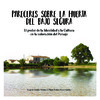LIBROS DE INTERES sobre la Huerta de la Vega Baja

Autor Don Jose Maria Ballester Sansano

EL RIEGO TRADICIONAL EN LA HUERTA DE ORIHUELA Y PUEBLOS DE SU MARCO Análisis de la Evolución Histórico-Jurídica. Tesis de Don Jose Maria Ballester Sansano

Autor Don Jose Maria Ballester Sansano

Pareceres sobre la Huerta del Bajo Segura. El poder de la Identidad y la Cultura en la valoración del Paisaje. Autores Gregorio Martinez Canales y Maria Dolores Ponce Sanchez

En el presente trabajo se describen y analizan las principales obras hidráulicas del sistema de riego tradicional de la comarca de la Vega Baja del Segura, concretamente, los azudes y los acueductos. Los azudes de toma, construidos en el cauce del río Segura, representan el inicio del sistema, desde donde parte una extensa y compleja red de acueductos constituida por acequias y azarbes, como elementos fundamentales, que distribuyen el agua para el regadío. En este estudio se ha llevado a cabo una amplia y profunda investigación documental, tomado datos de campo y captado imágenes in situ que, junto con los diagramas aportados, resultan imprescindibles para comprender la magnitud del sistema. Los resultados obtenidos han servido no sólo para catalogar y caracterizar los elementos que integran el sistema hidráulico del regadío tradicional de la Vega Baja del Segura, sino también para poner de manifiesto un ejemplo real de optimización de recursos hídricos en una zona del sureste peninsular español de escasa e irregular pluviometría. Asimismo, el estudio efectuado revela un sistema de riego sumamente eficiente desde un punto de vista cuantitativo y no tanto desde el cualitativo, debido a la presencia, entre otros contaminantes, de altas concentraciones de sales. | This paper describes and discusses the main hydraulic works of traditional irrigation system in the Vega Baja del Segura area, particularly the diversion dams and the aqueducts. The diversion dams, built on the bed of the Segura River, represent the beginning of the system from where part a vast and complex network of aqueducts, constituted by ditches and drainage ditches, as fundamental elements that distribute water for irrigation. An extensive and thorough documentary research has been carried out in this study. Field data and in-situ images have been gathered and, along with the provided diagrams, they are essential to understand the magnitude of the system. The results have served not only to catalog and characterize the elements comprising the hydraulic system of the traditional irrigation of the Vega Baja del Segura, but also to reveal a real example of optimization of water resources in an area of the Spanish peninsular Southeast of low and irregular rainfall. In addition, the study reveals a system of highly efficient irrigation from a quantitative point of view and not so much in the qualitative due to the presence of high concentrations of salts, among other pollutants.

